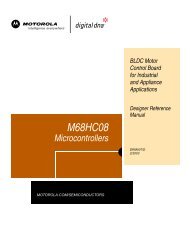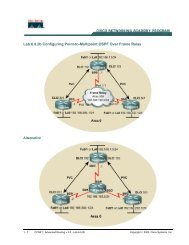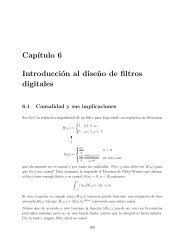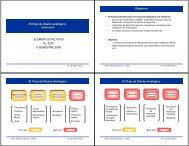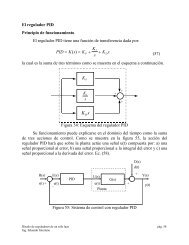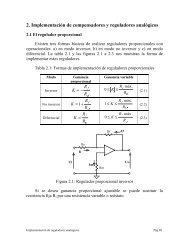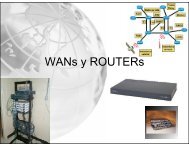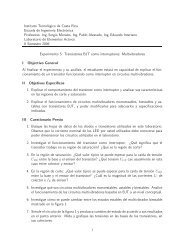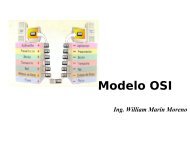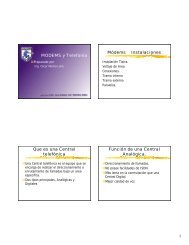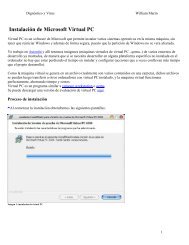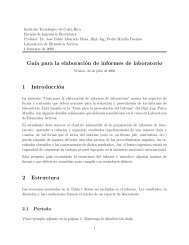Full Custom IC Desig..
Full Custom IC Desig..
Full Custom IC Desig..
Create successful ePaper yourself
Turn your PDF publications into a flip-book with our unique Google optimized e-Paper software.
<strong>Full</strong> <strong>Custom</strong> <strong>IC</strong> <strong>Desig</strong>n Flow Tutorial<br />
Using Synopsys <strong>Custom</strong> Tools<br />
By:<br />
Hamid Mahmoodi<br />
Mojan Norouzi<br />
Michael Chan<br />
Nano-Electronics & Computing Research Lab<br />
School of Engineering<br />
San Francisco State University<br />
San Francisco, CA<br />
Fall 2010<br />
San Francisco State University Nano‐electronics and Computing Research Lab 1
Table of Contents<br />
Introduction …………………………………………………………………………….. 3<br />
Part 1: Setting Up Your workspace …………………………………………………… 4<br />
Part 2: Creating a Cell View …………………………………………………………… 6<br />
Part 3: Simulation and Analysis Environment ………………………………………. 20<br />
Part 4: WaveView Measurement Tools and Features ……………………………….. 30<br />
Part 5: Creating Layout ………………………………………………………………... 40<br />
Part 6: Post Layout Simulation …………………………..………………………….... 68<br />
Part 7: Hierarchical <strong>Desig</strong>n ……………………………………………………………. 75<br />
San Francisco State University Nano‐electronics and Computing Research Lab 2
Introduction<br />
This manual assumes you are able to do some basic things in a Linux environment such as create<br />
a folder, change directories....etc. If you want to learn how to use Linux here are many good<br />
tutorials available on the web, such as this one: http://tldp.org/LDP/gs/node5.html. Figure I.1<br />
shows the design flow this tutorial will be implementing. In the first three parts of this manual<br />
you will design and simulate a CMOS inverter using <strong>Custom</strong> <strong>Desig</strong>nerSE in conjunction with<br />
Hspice and WaveView to visually assemble the circuit schematic, simulate it, and view the<br />
output waveforms. For further help you are encouraged to go to “Help” in the menu bar of<br />
CosmosSE. You will use Custon <strong>Desig</strong>nerSE to create a layout, and use Hercules to run a design<br />
rule check (DRC) on the layout based on the technology process. You will also use Hercules to<br />
make sure our inverter layout matches our schematic by running a Layout Versus Schematic<br />
(LVS) check. Finally, you will use the inverter we create in a gate level design of a buffer.<br />
Figure I.1: <strong>Custom</strong> design flow<br />
San Francisco State University Nano‐electronics and Computing Research Lab 3
Part 1: Setting up your workspace<br />
The first step is to login. Please refer to the login tutorial if you are having trouble logging in or<br />
running the following commands. If you are using a Linux machine not connected to<br />
hafez.sfsu.edu try using the following command to ensure you can use x- server:<br />
ssh -l username -X hafez.sfsu.edu<br />
To setup the library we will use the following command in the shell window:<br />
cp /packages/synopsys/setup/lib.defs ./<br />
cp<br />
/packages/process_kit/generic/generic_90nm/updated_oct2010/SAED_PDK90nm/display.tc<br />
l ./<br />
(Notice that there is a space between cp and /packages for the second copy command above)<br />
Notice that the above commands need to be run once after your first login. You do not need to<br />
rerun this command for future logins. Running the same copy commands more than once can<br />
overwrite saved directories resulting in lost files later on.<br />
To setup all the software we will use the following commands in the shell window. These<br />
commands must be run every time you use the Synopsys software:<br />
csh<br />
source /packages/synopsys/setup/full_custom.csh<br />
Notice that the csh and source commands set the environment and need to be run every time you<br />
login. To run an instance of <strong>Custom</strong> <strong>Desig</strong>ner simply type “cdesigner &”. Your command<br />
window should look like the one shown in Fig.1.<br />
San Francisco State University Nano‐electronics and Computing Research Lab 4
Figure 1: Shell commands<br />
<strong>Custom</strong> <strong>Desig</strong>ner Console should open up (Fig.2).<br />
Figure 2: <strong>Custom</strong> <strong>Desig</strong>ner Console<br />
Use File New Library to create a new library. A window will appear. Several lines in the<br />
window are to be filled out to create a new library and several are not which are inactive and are<br />
filled by default. Fill out the name field with a library name and fill out the directory field for a<br />
place to save it. For the “Import File” field, click the dot so you can edit the text field and copy<br />
and paste this file directory in the field:<br />
San Francisco State University Nano‐electronics and Computing Research Lab 5
packages/process_kit/generic/generic_90nm/updated_oct2010/SAED_PDK90nm/techfiles/saed<br />
90nm_1p9m_cd.tf<br />
After you have filled out the name, directory, and import file, click OK. See Fig.3.<br />
Figure 3: New Library<br />
Part 2: Creating a Cell View<br />
Use File New CellView to create a new Cell View under the library that you create in part 1<br />
(In this case called mylibrary). Enter a name for “Cell Name” and choose schematic for “View<br />
Name”. For the “Editor” choose SE-schematic (see Fig.4). Click OK.<br />
San Francisco State University Nano‐electronics and Computing Research Lab 6
Figure 4: New Cell View<br />
After you click Ok new window will open up called schematic editor (Fig.5)<br />
Figure 5: Schematic Editor Window<br />
In here we need to make sure that we are in right library.<br />
From your console window select Tools Technology Manager and then make sure the<br />
attachment of your library (in this case “mylibrary”) is SAED_PDK_90. If not, please click on it<br />
and change it (Fig.6).<br />
Figure 6: Technology Manager<br />
San Francisco State University Nano‐electronics and Computing Research Lab 7
Now go ahead and click on Add Instance or simply click on this icon in the schematic<br />
window. Select “SAED_PDK_90” for the library and select pmos4t and nmos4t for the cell<br />
while placing their respective parts on the schematic. For pmos4t width, assign 0.5um and for<br />
nmos4t width, assign 0.25um (Fig.7). You can also modify these properties later using the<br />
property editor by going to Edit Properties Property Editor and selecting the component<br />
you want to modify in schematic view.<br />
Figure 7: Add parts<br />
After placing the pmos and nmos transistors, the schematic should look like figure 8 below.<br />
San Francisco State University Nano‐electronics and Computing Research Lab 8
Figure 8: PMOS and NMOS<br />
Next add wires to the schematic, click and draw wires to the circuit using the mouse pointer,<br />
see figure 9 for wire connections. To deselect wire adding, press ESC. Now you need to give<br />
names to your wires. Please click on . Then you will see a wire name space on top to enter<br />
wire names. See Fig.10 for wire labeling.<br />
San Francisco State University Nano‐electronics and Computing Research Lab 9
Figure 9: Wire Connections<br />
Figure 10: Wire Names<br />
San Francisco State University Nano‐electronics and Computing Research Lab 10
Adding Pins<br />
To add pins to the schematic, go to Add Pin to add pins for input (VIN, AVDD, AVSS) and<br />
output (VOUT) for your schematic. You can type in a name for the pin and select whether the<br />
pin is an input or output port. Then place the pin on a wire or if the wire in schematic view<br />
already has a name you can click on the wire and the pin will get the name of the wire. Note that<br />
the pin names in schematic view should match the label names in layout view (AVDD, AVSS,<br />
VIN, VOUT, etc) for future reference. See figure 11 and figure 12 for reference on how to add<br />
pins. Afterwards your circuit should look similar to figure 13 below after you add the pins.<br />
Figure 11: Adding Pins<br />
San Francisco State University Nano‐electronics and Computing Research Lab 11
Figure 12: Adding Pins<br />
San Francisco State University Nano‐electronics and Computing Research Lab 12
Figure 13: Schematic with Pins<br />
San Francisco State University Nano‐electronics and Computing Research Lab 13
Save your schematic by clicking<br />
or go to <strong>Desig</strong>n Save.<br />
Now we want to create a symbol for the inverter schematic to use for future designs instead of<br />
redrawing it every time. To create a symbol for the inverter, go to <strong>Desig</strong>n New CellView <br />
From CellView. Make sure library and cell names match and click OK. See figure 14 below for<br />
reference.<br />
Figure 14: Generate CellView Window<br />
Now we have a transistor level model of an inverter (symbol). See figure 15 for reference.<br />
San Francisco State University Nano‐electronics and Computing Research Lab 14
Figure 15: Inverter Symbol<br />
You may also modify the appearance of the inverter symbol here by using the shape tools, Add<br />
Shape. Now save and close the symbol window.<br />
From the <strong>Custom</strong> <strong>Desig</strong>n Console, go to File New CellView and select mylibrary under<br />
the library column. Enter a new name for “Cell Name” in this case I used inverter_testbench<br />
and choose schematic for “View Name”. For the editor choose SE-schematic. Click OK. See<br />
figure 16 for reference. Note that this schematic file will be used as a sandbox for circuits using<br />
the inverter symbol we created earlier.<br />
San Francisco State University Nano‐electronics and Computing Research Lab 15
Figure 16: Creating a New Cell<br />
Now that you have a new schematic window, go to Add Instance. In the add instance<br />
window, select “mylibrary” as the library, “inverter” as the cell, and “symbol” for the view to<br />
select the inverter you just made and place it on the schematic. See figure 17 for reference.<br />
Also in the add instance window, select “analogLib” for the library and choose: vsource, vpulse<br />
and gnd for the cell while placing the part for each selection on the schematic.<br />
San Francisco State University Nano‐electronics and Computing Research Lab 16
Figure 17: Drawing an Instance of an Inverter<br />
Now add wires to the circuit using Add Wire and use Add Pin to add an output pin on the<br />
VOUT signal of the inverter so the schematic looks like figure 18 below. Don’t worry if your<br />
values for vpulse and vsource don’t match up with figure 18 since we will be modifying them<br />
next.<br />
San Francisco State University Nano‐electronics and Computing Research Lab 17
Figure 18: Test Circuit using Inverter Symbol<br />
By clicking on and selecting a component in schematic view, you can edit a component’s<br />
property. You can also use Edit Properties Property Editor to edit the properties of the<br />
parts. Select vpulse and modify its properties as shown in Fig.19. Select vsource and modify its<br />
properties as shown in Fig.19.<br />
San Francisco State University Nano‐electronics and Computing Research Lab 18
Figure 19: Edit property<br />
You final schematic should look like figure 18 above with the applied property edits for vpulse<br />
and vsource. The circuit is now ready for simulation. Also don’t forget to save your schematic by<br />
clicking<br />
or go to <strong>Desig</strong>n Save.<br />
San Francisco State University Nano‐electronics and Computing Research Lab 19
Part 3: Simulation and Analysis Environment (SAE)<br />
We need to run two types of simulation on our design:<br />
a) DC sweep analysis. (dc)<br />
b) Transient Analysis. (tran)<br />
To run SAE, go to Tools menu SAE in the schematic window. This will launch the window in<br />
Fig. 20, which consists of three main parts.<br />
1. <strong>Desig</strong>n Variables section.<br />
2. Output Section. (Choose the variables to be displayed after simulation).<br />
3. Enabled analysis for this test bench.<br />
Figure: 20: SAE Main Window<br />
The bar on the right contains the short cuts for the most commonly used commands in SAE.<br />
To set up simulation options:<br />
San Francisco State University Nano‐electronics and Computing Research Lab 20
1. Choose the appropriate Models for you instances. (transistors)<br />
a. Go to Setup Models Files.<br />
b. See window in Fig. 21.<br />
c. Click in section one. Use the file browser to determine the directory of your<br />
models library file. In the example, you will find it under:<br />
/packages/process_kit/generic/generic_90nm/updated_oct2010/SAED_PDK90nm<br />
/hspice/SAED90nm.lib<br />
d. In section two chose your transistor corner type (i.e. TT,FF,SS,SF and FS).<br />
Pick TT_12.<br />
e. Click OK.<br />
Figure 21: Models Files Window<br />
2. To select the analysis type:<br />
a. Go to Setup Analysis, the window in Fig.22 will appear.<br />
b. Stay in the General tab.<br />
c. Select tran. (For transient analysis)<br />
i. Fill out the options as shown in Fig.22, where:<br />
ii. Start Time = when the simulation begins.<br />
iii. Time Step = when to recalculate the variables.<br />
iv. Stop Time = when to stop your simulation.<br />
d. Now check the enable box at the lower left corner.<br />
e. Click Apply.<br />
f. Select dc. (For DC sweep)<br />
i. Fill out the options as shown in Fig.23, where:<br />
ii. Sweep Variable = the variable you want to change. (Select Source)<br />
iii. Sweep type= describe the relation between sweep points.<br />
iv. Start = min value for the variable.<br />
v. Stop = the Max value for the variable.<br />
San Francisco State University Nano‐electronics and Computing Research Lab 21
vi. Step size= the difference between each two reading.<br />
g. Now check the enable box at the lower left corner.<br />
h. Click OK.<br />
Figure 22: Transient Simulation Window<br />
San Francisco State University Nano‐electronics and Computing Research Lab 22
Figure 23: DC Simulation Window<br />
3. The following step is to choose the desired simulations results and select the nodes in<br />
the circuit to measure. In section TWO of Fig: 20 do the following steps:<br />
To setup the circuit output voltage:<br />
a. Click under the output field, and write “Vout” or a name for an output variable<br />
of the inverter.<br />
b. Click under the expression column and choose the output node from the<br />
schematic. In this case, click on and select the wire labeled “vout” as shown<br />
below in figure 24 in the schematic window. You can also write an equation that<br />
uses the values of some nodes in that schematic.<br />
c. Under analysis, just check the simulation option. Select the one that applies for<br />
this variable. (For now select both of them dc and tran).<br />
To setup the circuit input voltage:<br />
San Francisco State University Nano‐electronics and Computing Research Lab 23
a. Click under the output field in a new row, and write “Vin” or a name for an<br />
input variable of the inverter.<br />
b. In the same row, click under the expression column and choose the input node<br />
from the schematic. In this case, click on and select the wire labeled “vin”<br />
as shown below in figure 24 in the schematic window.<br />
c. Under analysis, just check the simulation option. Select the one that applies for<br />
this variable. (For now select both of them dc and tran).<br />
To setup the circuit source current:<br />
a. Click under the output field in a new row, and write “isupply” or a name for a<br />
current variable.<br />
b. In the same row, click under the expression column and choose the voltage<br />
source from the schematic. In this case, click on and select the voltage<br />
source labeled “V1” as shown below in figure 24 in the schematic window.<br />
c. Under analysis, just check the simulation option. Select the one that applies for<br />
this variable. (For now select both of them dc and tran).<br />
Afterwards, the SAE window should look something similar to figure 25 below. Note<br />
that the expression values in figure 25 may not match with your values which is fine<br />
since those are dependent on the names used in the schematic for the voltage sources and<br />
wires.<br />
San Francisco State University Nano‐electronics and Computing Research Lab 24
Figure 24: Clicking on the Schematic Window<br />
San Francisco State University Nano‐electronics and Computing Research Lab 25
Figure 25: Updated SAE Window<br />
4. Save your simulation option by going to Session Save State, select OpenAccess<br />
from the main three options at the top. Then name the state without any spaces in the<br />
name. See figure 26 for reference. Click OK when done.<br />
San Francisco State University Nano‐electronics and Computing Research Lab 26
Figure 26: Save State Window<br />
To run the simulation:<br />
1. Go to Simulation Netlist and Run, in the SAE window (fig. 25).<br />
2. Simulation time depends on the complexity of the design.<br />
The status of simulation is reported in <strong>Custom</strong> <strong>Desig</strong>ner Console window. If you see<br />
“Simulation completed successfully” it means that your simulation is successfully done<br />
(Fig.27).<br />
San Francisco State University Nano‐electronics and Computing Research Lab 27
Figure 27: <strong>Custom</strong> <strong>Desig</strong>ner Console<br />
3. A WaveView program window will appear which contains the graphs for the output<br />
variables you specified.<br />
4. At the lower left corner, there are two tabs (dc and tran). Click a tab to display the<br />
respective waveform.<br />
5. See Fig 28 for the tran tab results.<br />
6. See Fig 29 for the dc tab results<br />
At this point, you have created a schematic cell and ran a DC and transient simulation.<br />
San Francisco State University Nano‐electronics and Computing Research Lab 28
Figure 28: Transient Analysis Wave in WaveView<br />
Figure 29: DC Sweep Analysis Wave in WaveView<br />
San Francisco State University Nano‐electronics and Computing Research Lab 29
Part 4: WaveView Measurement Tools and Features<br />
The measurement tool in the WaveView window provides many methods for measuring the<br />
waveforms. Here is a list of several features and measurements you can do in WaveView:<br />
Zooming In and Out:<br />
To zoom in on your waveform, click to do a vertical or horizontal zoom by dragging a box<br />
over the waveform with the mouse. Click to unzoom. Also you can press X for a full unzoom<br />
of the waveform.<br />
Grouping and Ungrouping Signals:<br />
First off, it is handy to know how to group and ungroup waveforms in WaveView. See figure 30<br />
for ungrouping waveforms and see figure 31 for grouping waveforms.<br />
Figure 30: Ungrouping Waveforms<br />
San Francisco State University Nano‐electronics and Computing Research Lab 30
Figure 31: Grouping Waveforms<br />
Delay Measurements of Vin and Vout at 50% to 50%:<br />
To measure delay between the input and output signals of the inverter at 50% select the tran tab<br />
in the bottom left hand corner of the WaveView window. Group the Vout and Vin waveforms<br />
together so the two waves overlap each other (see figure 31 on how to group signals). Open the<br />
measurement tool by going to Tools Measurement… or by clicking in the WaveView<br />
window. Click the All tab in the measurement tool window and fill out the options as shown<br />
below in figure 32. Click Ok when done.<br />
San Francisco State University Nano‐electronics and Computing Research Lab 31
Figure 32: Delay Measurement Tool<br />
After clicking Ok, a delay measurement box will appear on the waveform. Just drag the box to<br />
the waveform you want to measure (in this case the Vin and Vout overlapping waveforms) and<br />
the delay value will appear in the box. You can also drag the delay measurement box along<br />
different valid points of the waveform to get more delay values. See figure 33 below for the<br />
delay measurements box.<br />
San Francisco State University Nano‐electronics and Computing Research Lab 32
Figure 33: Delay Waveform Measurement<br />
Rise/Fall Time Measurements at 90% and 10% for Vout:<br />
To measure fall and rise time, select the tran tab in the bottom left hand corner of the WaveView<br />
window and ungroup all the waveforms as described in figure 30. Open the measurement tool by<br />
going to Tools Measurement… or by clicking in the WaveView window. Click the All<br />
tab in the measurement tool window and fill out the options as shown below in figure 34. Click<br />
Ok when done.<br />
San Francisco State University Nano‐electronics and Computing Research Lab 33
Figure 34: Rise/Fall Measurement Tool<br />
After clicking Ok, a rise/fall measurement box will appear on the waveform. You can drag the<br />
rise/fall measurement box along the Vout waveform to get the rising and falling delay times.<br />
Notice that when the rise/fall measurement box shows a rising red curve the tool is measuring<br />
rising delay time from 10% of the signal to 90% of the signal. Also when the rise/fall<br />
measurement box shows a falling green curve the tool is measuring the falling delay time from<br />
90% of the signal to 10% of the signal. See figure 35 for reference, it shows two measurement<br />
boxes and zooms in on Vout.<br />
San Francisco State University Nano‐electronics and Computing Research Lab 34
Figure 35: Rise/Fall Waveform Measurement<br />
Average Current Measurement:<br />
To measure average current, select the tran tab in the bottom left hand corner of the WaveView<br />
window and ungroup all the waveforms as described in figure 30. Delete the Vout and Vin<br />
waveforms so only the isupply waveform shows. You can delete a waveform by selecting its<br />
name in the signal list on the left side of the WaveView window and pressing delete on the<br />
keyboard and clicking ok. You can always recover these signals later by clicking Plot on the<br />
SAE window.<br />
Open the measurement tool by going to Tools Measurement… or by clicking in the<br />
WaveView window. Click the All tab in the measurement tool window and fill out the options as<br />
shown below in figure 36. Click Ok when done.<br />
San Francisco State University Nano‐electronics and Computing Research Lab 35
Figure 36: Average Measurement Tool<br />
After clicking Ok, an average measurement box will appear on the waveform. Drag the box<br />
toward the waveform until it displays the average value. See figure 37 below for reference.<br />
San Francisco State University Nano‐electronics and Computing Research Lab 36
Figure 37: Average Waveform Measurement<br />
Frequency Measurement:<br />
To measure frequency, select the tran tab in the bottom left hand corner of the WaveView<br />
window and ungroup all the waveforms as described in figure 30.<br />
Open the measurement tool by going to Tools Measurement… or by clicking in the<br />
WaveView window. Click the All tab in the measurement tool window and fill out the options as<br />
shown below in figure 38. Click Ok when done.<br />
San Francisco State University Nano‐electronics and Computing Research Lab 37
Figure 38: Frequency Measurement Tool<br />
After clicking Ok, a frequency measurement box will appear on the waveform. Drag the box<br />
toward the waveform you want to measure until it displays the frequency value. See figure 39<br />
below for reference.<br />
San Francisco State University Nano‐electronics and Computing Research Lab 38
Figure 39: Frequency Waveform Measurement<br />
San Francisco State University Nano‐electronics and Computing Research Lab 39
Part 5: Creating Layout<br />
To draw a layout, it is strongly recommended that you make yourself familiar with the Lambda<br />
Rules. This will help in reducing the layout design cycle time and debugging the errors identified<br />
by the <strong>Desig</strong>n Rules Check (DRC). You can find the guide with the rules for the 90nm<br />
technology we are using here:<br />
/packages/process_kit/generic/generic_90nm/updated_oct2010/SAED_PDK90nm/documentatio<br />
n<br />
File: <strong>Desig</strong>nRules.pdf<br />
It is also suggested that you run the DRC throughout the layout process, instead of waiting until<br />
you have completed your layout to run it. This may help in finding errors you are making early<br />
on, and correct your mistake before you repeat throughout the layout.<br />
Important: If you have errors in your DRC report, look for the coordinates that are listed<br />
by each error. These will allow you to pinpoint where the error is on your layout.<br />
First, open <strong>Custom</strong> <strong>Desig</strong>nerLE. If your project library is already open in <strong>Custom</strong> <strong>Desig</strong>nerSE,<br />
go to File New CellView on you <strong>Custom</strong> <strong>Desig</strong>ner Console. Make sure the name of the<br />
cell is the same as the schematic cell you are making the layout for. In this case, it is inverter (see<br />
Fig.40). Click OK and the new layout will open (see Fig.41).<br />
Figure 40: Creating a New Layout<br />
San Francisco State University Nano‐electronics and Computing Research Lab 40
Figure 41: Layout Window<br />
Go to ruler by clicking on . Click once to start drawing the ruler and again to end it. Draw<br />
two rulers about the lengths shown in figure 42 (about 3 micrometers by 3 micrometers is a good<br />
start). Select the NWELL layer in the layers panel on the right and select Create Rectangle<br />
(Fig.42).<br />
Draw a rectangle that approximately fits the dimensions of the rulers you set. You can always<br />
adjust the dimensions of this rectangle by using the tools (stretch) that existed on left side of<br />
layout window then clicking the side you want to stretch.<br />
San Francisco State University Nano‐electronics and Computing Research Lab 41
Figure 42: Drawing Rulers and NWell Layer<br />
After you have created an N-well, move your mouse over it. Notice at the top left there are two<br />
fields that tell you what layer you are on and the coordinates. This is useful information if you<br />
are having trouble figuring out what a layer is and when you are fixing errors found in DRC.<br />
Now we are going to make diffusion areas for PMOS, NMOS and body connections. From our<br />
schematic, we know that the width of the PMOS should be 0.5um and the width of NMOS is<br />
0.25um (Fig.43). The location of the diffusion should be similar to the ones in Fig. 44. There are<br />
two horizontal diffusion areas that are the NMOS and PMOS devices, and two vertical rectangles<br />
that will be the body connections. Place rulers down to help you make sure the width of the<br />
diffusion areas for the NMOS and PMOS match our schematic area exactly. Select the “DIFF”<br />
layer and again use the “Create Rectangle” tool to draw the diffusion area. Use rulers to<br />
check the width of the rectangles. If the widths are different than the widths of the devices in the<br />
schematic, you will not pass LVS. You can also use the property editor in Edit Property<br />
Editor to change the dimensions of the rectangle to exact values.<br />
Figure 43: Drawing Diffusion<br />
San Francisco State University Nano‐electronics and Computing Research Lab 42
Figure 44: Layout with NWell and Diffusion<br />
Now we will add the P-implant and N-implant areas. When manipulating layers on top of each<br />
other sometimes it is useful to “hide” a layer, like you would do in a program like Photoshop.<br />
You can do hide or reveal layers in Cosmos by clicking the .<br />
Use the P-implant and N-implant layers with the “Create Rectangle” to cover and surround the<br />
diffusion areas. It is important to note that the P-IMP is drawn to the edge of the NWELL where<br />
the NWELL meets the NIMP. This can be seen in Fig. 45. The PMOS area should be covered<br />
San Francisco State University Nano‐electronics and Computing Research Lab 43
with P-IMP and the NMOS with N-IMP, except for the body connections which have the<br />
opposite implantation.<br />
Figure 45: Drawing PIMP and NIMP Layers<br />
Now select the POLY layer and use the “Create Path” tool (Fig.46) to draw a strip of poly<br />
through both PMOS and NMOS diffusion areas. Make sure the poly is sticking out past the<br />
diffusion areas by at least the amount specified in the design rule manual. When drawing the<br />
Poly path, be sure to make sure the thickness is 0.1um to match the transistor lengths in the<br />
schematic, see figure 49 to set width/thickness for the draw path tool. Create a rectangle of poly<br />
in the center of the strip that would be used for the input signal, see fig. 47.<br />
San Francisco State University Nano‐electronics and Computing Research Lab 44
Figure 46: Drawing a Path<br />
San Francisco State University Nano‐electronics and Computing Research Lab 45
Figure 47: Drawing Poly<br />
Select the “CO” (contact) layer and use the Create Rectangle or Create Polygon tool in<br />
conjunction with rulers to make a contact 0.13 by 0.13. You can also use the property editor to<br />
get these exact values. After you have created one contact click on and the contact and make<br />
a copy to place the other contacts. Contact placements are shown in Fig. 48. Check to see that<br />
your contact placements meet the design rules.<br />
San Francisco State University Nano‐electronics and Computing Research Lab 46
Figure 48: Drawing Contacts<br />
Select the M1 layer and again select the “Create Path” tool. This time in the “Create Path”<br />
window that pops ups, click on the width box to then enter 0.16 in the Width field as shown in<br />
fig.49.<br />
Figure 49: Modifying Width<br />
San Francisco State University Nano‐electronics and Computing Research Lab 47
Draw the M1 layer the way it is shown in Fig.50. Make sure the metal is covering the contacts by<br />
the amount specified in the design rule manual. You can also draw rectangles over the contacts<br />
to cover them more.<br />
Figure 50: Drawing Metal Connections<br />
Select the M1PIN layer. Select the “Create Text Label” tool and place text labels labeled<br />
as AVDD, AVSS, VIN, and VOUT (see Fig. 51). Note that you need to match the label names in<br />
layout as the labeled pins in the schematic in order to pass LVS (Layout vs Schematic) later. You<br />
have now completed the initial layout and can move onto DRC. Save your layout by going to<br />
<strong>Desig</strong>n Save.<br />
San Francisco State University Nano‐electronics and Computing Research Lab 48
Figure 51: Labeling Connections<br />
San Francisco State University Nano‐electronics and Computing Research Lab 49
Running DRC<br />
After the inverter layout has been drawn to accurately represent the schematic, to verify that the<br />
layout meets all the basic design rules, we need to run a DRC (<strong>Desig</strong>n Rule Check). Save the<br />
layout cell by clicking on Save. In <strong>Custom</strong> <strong>Desig</strong>ner Editor, go to Verification DRC Setup<br />
and Run.<br />
Locate the runset file rules.drc.9m_saed90ev from the following directory and click Ok (Fig<br />
52).<br />
Directory:<br />
/packages/process_kit/generic/generic_90nm/updated_oct2010/SAED_PDK90nm/hercules/drc<br />
Figure 52: Runset File<br />
For Run Dir, choose your current directory and for tools chose Hercules. Make sure that you<br />
select OpenAccess as a format Fig. 53.<br />
San Francisco State University Nano‐electronics and Computing Research Lab 50
Figure 53: DRC Setup<br />
Click OK. After DRC is done, you will see a message on your Console indicating that DRC is<br />
done, see Fig. 54.<br />
Figure 54: DRC Confirmation<br />
When the layout is free from all the errors and meets all the design rules, the output file<br />
inverter.LAYOUT_ERRORS will say CLEAN as In Fig.55 and 56. If there are some errors in<br />
the layout, it will say ERROR and the error details are specified in this file. If you have errors in<br />
your DRC, check the location and type of errors and correct them. This may take multiple<br />
iterations. In the beginning it is advisable to try to correct only a few errors and run the DRC<br />
again to check if you corrected them properly. It is important to pass the DRC check before you<br />
proceed to LVS and parasitic extraction.<br />
San Francisco State University Nano‐electronics and Computing Research Lab 51
Figure 55: DRC Error File<br />
Figure 56: DRC Passed Confirmation<br />
Also for debugging, you can go to Verification Debug, see Fig. 57.<br />
San Francisco State University Nano‐electronics and Computing Research Lab 52
Figure 57: DRC Errors<br />
San Francisco State University Nano‐electronics and Computing Research Lab 53
Running LVS<br />
The LVS (Layout versus Schematic) check performs LVS comparison to verify that the design<br />
layout accurately represents the electronic equivalent of the design schematic. Hercules LVS<br />
verifies whether the physical design design matches the schematic by: extracting the devices,<br />
verifying the connectivity between the devices and comparing the extracted information with the<br />
schematic netlist.<br />
Notice that in order to pass LVS, schematic names and layout names must match one to one.<br />
Also transistor dimensions for gate width and length in layout and schematic must match.<br />
See figure 58 for reference.<br />
Figure 58: Layout versus Schematic<br />
San Francisco State University Nano‐electronics and Computing Research Lab 54
In the layout window go to Verification LVS Setup and Run.<br />
Please make sure your setup mirrors the Fig.59.<br />
Under main option select the file “rules.lvs.9m_saed90.ev” as the Runset File in the following<br />
directory:<br />
/packages/process_kit/generic/generic_90nm/updated_oct2010/SAED_PDK90nm/hercules/lvs/ru<br />
les.lvs.9m_saed90.ev<br />
Figure 59: LVS Setup Main Tab<br />
San Francisco State University Nano‐electronics and Computing Research Lab 55
Under Netlisting Option tab, for the netlister, select: CDL if not already selected. See Fig. 60.<br />
Figure 60: LVS Setup Netlisting Options Tab<br />
San Francisco State University Nano‐electronics and Computing Research Lab 56
Under Control Variables tab set DEC_TYPE Value to PEX_DECK, see fig. 61.<br />
Figure 61: LVS Setup Control Variables Tab<br />
San Francisco State University Nano‐electronics and Computing Research Lab 57
Under the <strong>Custom</strong> Options tab, leave the defaults as shown in figure 62. Click OK when done.<br />
Figure 62: LVS Setup <strong>Custom</strong> Options Tab<br />
On your Console window you should get the following message as in Fig. 63 if you passed LVS.<br />
San Francisco State University Nano‐electronics and Computing Research Lab 58
Figure 63: LVS Done Confirmation<br />
Also you can go to LVS Debugger to see the result of you LVS Fig. 64.<br />
Figure 64: LVS Debugger<br />
Now open the directory that you specified as the Hercules Run directory, in this case<br />
./inverter.hercules.lvs. There should be many new files created by Hercules there now. Open<br />
inverter.LVS_ERRORS If you have done everything correctly You should see a “PASS” in the<br />
inveter.LVS_ERRORS file. If it says “FAIL” read the errors it reports and try to fix them on the<br />
schematic or layout. If the error is in the schematic, make sure to rebuild the spice netlist. Run<br />
Hercules again and see if inverter.LVS_ERRORS now says “PASS” Fig. 65.<br />
San Francisco State University Nano‐electronics and Computing Research Lab 59
Figure 65: LVS Errors File<br />
Extracting Parasitics<br />
After passing DRC and LVS you can now move on to LPE (Layout Parasitic Extraction). In this<br />
phase, resistive and capacitive components will be extracted from the layout. In layout window<br />
go to Verification LPE Setup and Run. Please make sure your setup mirrors the Fig. 66<br />
for the Main tab.<br />
San Francisco State University Nano‐electronics and Computing Research Lab 60
Figure 66: LPE Setup Main Tab<br />
Under the Extraction Option tab select the following file for Mapping File.<br />
/packages/process_kit/generic/generic_90nm/updated_oct2010/SAED_PDK90nm/starrcxt/saed9<br />
0nm.map<br />
For Milkyway XTR View select the hercules.lvs folder created from running LVS, then select<br />
the TOPCELLNAME_MILKWAY folder. See fig 67 below.<br />
Make sure the other options in this tab match up with figure 67.<br />
San Francisco State University Nano‐electronics and Computing Research Lab 61
Figure 67: LPE Setup Extraction Options<br />
San Francisco State University Nano‐electronics and Computing Research Lab 62
Under Output Options tab type make sure that you have the same setup as shown in Fig. 68.<br />
Make sure the following map files are set as noted below if not already set by default.<br />
Device Map:<br />
/packages/process_kit/generic/generic_90nm/updated_oct2010/SAED_PDK90nm/starrcxt/device<br />
_map<br />
Layer Map:<br />
/packages/process_kit/generic/generic_90nm/updated_oct2010/SAED_PDK90nm/starrcxt/output<br />
_layer_map<br />
Figure 68: LPE Setup<br />
San Francisco State University Nano‐electronics and Computing Research Lab 63
There is nothing you need to change under the custom options tab so you can leave that as<br />
default.<br />
Now click on OK. Then you will see <strong>Custom</strong>er <strong>Desig</strong>ner Text Viewer as Fig. 69.<br />
Figure 69: Console Output<br />
After some time you should able to see the following message as shown in the console window if<br />
the parasitics were generated correctly. See figure 70.<br />
San Francisco State University Nano‐electronics and Computing Research Lab 64
Figure 70: Passing LPE<br />
After LPE has successfully run, a parasitic view window should open. See figure 71 and 72 for<br />
reference. The RC components are very small in the window that opens up (fig 71) so you may<br />
need to zoom in to see the details (fig 72). It may help to drag a box around the RC components<br />
using the mouse cursor to highlight them, then zoom in to see them. Also note that your parasitic<br />
view may not match exactly as shown below which is fine since this depends on differences in<br />
layout<br />
San Francisco State University Nano‐electronics and Computing Research Lab 65
Figure 71: Parasitic View<br />
San Francisco State University Nano‐electronics and Computing Research Lab 66
Figure 72: Parasitic View Zoom<br />
You have successfully generated the parasitic view for the inverter and are ready to run post<br />
layout simulation. Save the parasitic view with <strong>Desig</strong>n Save. The parasitic view will be saved<br />
as “starrc” for the view name.<br />
San Francisco State University Nano‐electronics and Computing Research Lab 67
Part 6: Post Layout Simulation<br />
After parasitic extraction we want to apply the parasitics to the schematic for a more accurate<br />
representation of our inverter and test it. From the <strong>Custom</strong> <strong>Desig</strong>ner Console window go to File<br />
Open <strong>Desig</strong>n and open the inverter circuit schematic created earlier.<br />
Select the following options for the following columns:<br />
Libraries: mylibrary<br />
Cells: inverter_schematic<br />
Views: schematic<br />
See figure 73 for reference. Once all options are highlighted, click Open and the schematic that<br />
was created earlier for testing the inverter will open, see figure 74 for reference.<br />
Figure 73: Opening Circuit with Inverter Schematic<br />
San Francisco State University Nano‐electronics and Computing Research Lab 68
Figure 74: Testbench Circuit for Inverter<br />
After opening the testbench circuit, make sure the circuit is similar to the one shown in figure 74.<br />
Now the parasitics need to be loaded into the inverter cell used in the circuit. From the <strong>Custom</strong><br />
<strong>Desig</strong>ner Console window, go to File New CellView.<br />
In the New CellView window, create a new configurations file as follows:<br />
- Select inverter_testbench for the cell.<br />
- Set view name to config<br />
San Francisco State University Nano‐electronics and Computing Research Lab 69
- Set editor to HE – config<br />
See figure 75 below for reference and click OK.<br />
Figure 75: Configurations File Setup<br />
A Hierarchy Editor window will display. Setup the view and list options as noted in figure 76<br />
below.<br />
View: schematic<br />
View Search List: schematic hspice symbol<br />
View Stop List: symbol<br />
San Francisco State University Nano‐electronics and Computing Research Lab 70
Figure 76: Hierarchy Editor<br />
In order to map the parasitics generated from LPE to your inverter cell, select starrc under the<br />
“Selected” column for the inverter instance, see figure 77 for reference. The format for your<br />
inverter instance name in the instance column is schematic_instance_name (mylibrary, inverter).<br />
Notice that as starrc is selected, resistor and capacitor instances will show up under the instance<br />
column, this substitution replaces the inverter cell with its equivalent schematic containing its<br />
resistive and capacitive components. Afterwards save the settings by going to File Save.<br />
For future reference, to apply parasitics for a general case, a schematic must have its equivalent<br />
schematic symbol and layout created since a layout is used to generate the parasitics and a<br />
schematic symbol is used as a vessel to hold the parasitics. The testbench schematic is created to<br />
test the symbol containing the schematic with its applied parasitics.<br />
San Francisco State University Nano‐electronics and Computing Research Lab 71
Figure 77: Loading Parasitics into the Inverter<br />
To start simulation with parasitics, go to File Open <strong>Desig</strong>n from the <strong>Custom</strong> <strong>Desig</strong>ner<br />
Console window. In the Open <strong>Desig</strong>n window that opens, select inverter_testbench under the<br />
cells column and config under the views column and right click on config under views. Select<br />
Open <strong>Desig</strong>n from the drop down menu. See figure 78 below for reference.<br />
San Francisco State University Nano‐electronics and Computing Research Lab 72
Figure 78: Open <strong>Desig</strong>n with Parasitics<br />
Afterwards, a schematic view should open up with parasitics applied, see figure 79 below for<br />
reference. To check if the parasitics were applied, you can double click on the inverter<br />
symbol/cell and it should display the same parasitics view that was generated from running LPE.<br />
To change between parasitic and schematic views, select the desired view in the red box noted in<br />
figure 80.<br />
San Francisco State University Nano‐electronics and Computing Research Lab 73
Figure 79: Schematic with Parasitics Applied to the Inverter<br />
Figure 80: Changing Between Views<br />
San Francisco State University Nano‐electronics and Computing Research Lab 74
Now go ahead and simulate your circuit as you did previously in Part 3 of the tutorial. From the<br />
schematic window, go to Tools SAE to open a new SAE window. When comparing the two<br />
waveforms (inverter parasitics to inverter without parasitics) take note of the difference between<br />
delays from VIN to VOUT for transient waveforms.<br />
Part 7: Hierarchical <strong>Desig</strong>n<br />
Using smaller instances of circuits to create a larger design is what hierarchical design is all<br />
about. In this section, we use an inverter we created earlier and use several instances of it to<br />
create a five stage oscillator in schematic and layout views.<br />
Create a new schematic for the ring oscillator by going to New CellView from the <strong>Custom</strong><br />
<strong>Desig</strong>ner Console and setup the options as shown in figure 81 below. The setup is as follows:<br />
Library: mylibrary<br />
Cell Name: ringOscillator<br />
View Name: schematic<br />
Editor: SE - schematic<br />
Click OK when done.<br />
San Francisco State University Nano‐electronics and Computing Research Lab 75
Figure 81: Ring Oscillator Schematic Setup<br />
In the schematic window, building a ring oscillator circuit with pins as shown below in figure 82.<br />
For the inverter instances, look for them in Add Instance to open the add instance window.<br />
In the add instance window, choose mylibrary for library, inverter for cell, and symbol for the<br />
view and place five instances of the inverter on the schematic.<br />
Add wires with Add Wire.<br />
San Francisco State University Nano‐electronics and Computing Research Lab 76
For the pins, go to Add Pins and place two input pins for the AVDD and AVSS signals, and<br />
place five input/Output pins at each inverter output. For the five input/output pins, I called them<br />
VIO1-5 in the schematic. Feel free to give the wires the same names as the pins using Add <br />
Wire Name.<br />
Figure 82: Ring Oscillator Schematic<br />
Save your schematic using <strong>Desig</strong>n Save. Now create a symbol of your inverter using <strong>Desig</strong>n<br />
New CellView From CellView. Make sure your options match up as shown below in<br />
figure 83 and click OK.<br />
San Francisco State University Nano‐electronics and Computing Research Lab 77
Figure 83: Ring Oscillator Symbol Setup<br />
After clicking OK, a new schematic window opens up with the ring oscillator symbol. Feel free<br />
to move around the pin placements for a better pin organization. See figure 84 below for<br />
reference. Save the symbol when done with <strong>Desig</strong>n Save.<br />
San Francisco State University Nano‐electronics and Computing Research Lab 78
Figure 84: Ring Oscillator Symbol<br />
Now create a new schematic to use as a testbench for the ring oscillator by going to New <br />
CellView from the <strong>Custom</strong> <strong>Desig</strong>ner Console and setup the options as shown in figure 85 below.<br />
The setup is as follows:<br />
Library: mylibrary<br />
Cell Name: ringOscillator_testbench<br />
View Name: schematic<br />
Editor: SE - schematic<br />
San Francisco State University Nano‐electronics and Computing Research Lab 79
Click OK when done.<br />
Figure 85: Ring Oscillator Testbench Setup<br />
Afterwards a new schematic window should open. In the new schematic window, setup the ring<br />
oscillator testbench circuit as shown in figure 86.<br />
To place a ringOscillator instance, look for them in Add Instance to open the add instance<br />
San Francisco State University Nano‐electronics and Computing Research Lab 80
window. In the add instance window, choose mylibrary for library, ringOscillator for cell, and<br />
symbol for the view and place an instance of your ring oscillator on the schematic. Also place an<br />
instance of ground and a voltage source in the schematic. You can find these instances under<br />
library: analogLib and cell: gnd and cell: vsource respectively. For the voltage source, set the<br />
voltage to 1.2 volts.<br />
Add wires with Add Wire.<br />
For the pins, go to Add Pins and place five output pins for each of the five VIO# pins. Feel<br />
free to give the wires the same names as the pins using Add Wire Name.<br />
Figure 86: Ring Oscillator Testbench Circuit<br />
San Francisco State University Nano‐electronics and Computing Research Lab 81
Save with <strong>Desig</strong>n Save once your testbench circuit is done. Now we need to create a new<br />
layout so go to New CellView from the <strong>Custom</strong> <strong>Desig</strong>ner Console and setup the options as<br />
shown in figure 87 below.<br />
Library: mylibrary<br />
Cell Name: ringOscillator<br />
View Name: layout<br />
Editor: LE - layout<br />
Click OK when done.<br />
Figure 87: Ring Oscillator Layout Setup<br />
In the new layout window, we can use the layout of the inverter created earlier to build a ring<br />
oscillator circuit. Go to Create Instance to open up a new create instance window. In the<br />
window select mylibrary for library, inverter for cell, and layout for the view and place five<br />
San Francisco State University Nano‐electronics and Computing Research Lab 82
instances of the inverter layout on the layout screen. See figure 88 for reference.<br />
Figure 87: Placing Five Inverter Layout Instances<br />
Notice that the layout components for the inverter layouts don’t display. This is because the<br />
inverter layouts are hiding one level up in the hierarchy. In order to view them, change the<br />
hierarchy bounds as shown in figure 88 below. The numbers represent a range of hierarchy levels<br />
that are displayed where the left number is the lower limit and the right number is the higher<br />
limit. Afterwards the inverter layouts are viewable as shown in figure 89.<br />
San Francisco State University Nano‐electronics and Computing Research Lab 83
Figure 88: Placing Five Inverter Layout Instances<br />
Figure 89: Viewing Inverter Layout Instances<br />
Now draw metal paths with Create Path using the M1 layer under the LPP panel. Connect all<br />
AVDD signals with a single M1 connection and all AVSS signals with a single M1 connection.<br />
Also connect the output of an inverter to the input of the next inverter using the M1 layer. See<br />
figure 90 for M1 connections.<br />
In addition you need to add labels for the metal connections just added. To add labels, select the<br />
M1PIN layer in the LPP panel and go to Create Text Label. Enter a name for each label<br />
in the box noted in figure 91 and place the text labels as noted by the red boxes in figure 90.<br />
Label names used are: AVDD, AVSS, VIO1, VIO2, VIO3, VIO4, and VIO5. Remember that<br />
in order to pass LVS, your M1PIN label names in layout need to match up with the pin names<br />
from your ring oscillator schematic. Save the layout.<br />
San Francisco State University Nano‐electronics and Computing Research Lab 84
Figure 90: Ring Oscillator Layout<br />
Figure 91: Label Text<br />
After your layout matches figure 90, go to Verification DRC Setup and Run to setup and<br />
run DRC (as done earlier in part 5 of the tutorial). Your options for DRC should match figure 92.<br />
Leave the options on the custom tab as their defaults. Click OK when done.<br />
Runset file for main tab:<br />
/packages/process_kit/generic/generic_90nm/updated_oct2010/SAED_PDK90nm/hercules/drc/r<br />
ules.drc.9m_saed90.ev<br />
San Francisco State University Nano‐electronics and Computing Research Lab 85
Figure 92: DRC Setup<br />
San Francisco State University Nano‐electronics and Computing Research Lab 86
Debug any DRC errors that come up. When DRC is passed, continue on to Verification LVS<br />
Setup and Run to run LVS. In LVS, setup the options as shown in figure 93 and figure 94<br />
and leave the defaults for the custom options tab. Click OK when done.<br />
Runset file under Main tab:<br />
/packages/process_kit/generic/generic_90nm/updated_oct2010/SAED_PDK90nm/hercules/lvs/ru<br />
les.lvs.9m_saed90.ev<br />
Figure 93: LVS Setup<br />
San Francisco State University Nano‐electronics and Computing Research Lab 87
Figure 94: LVS Setup<br />
San Francisco State University Nano‐electronics and Computing Research Lab 88
At this point if there are any LVS errors, an error window will show up. Debug any errors you<br />
have and rerun LVS until you pass it. After running LVS successfully, go to Verification <br />
LPE Setup and Run to run parasitic extraction.<br />
Under Extraction Option tab select the following file for Mapping File.<br />
/packages/process_kit/generic/generic_90nm/updated_oct2010/SAED_PDK90nm/starrcxt/saed9<br />
0nm.map<br />
For Milkyway XTR View select the hercules.lvs folder created from running LVS, then select<br />
the TOPCELLNAME_MILKWAY folder. See figure 95 below for reference on setups.<br />
Figure 95: LPE Setup<br />
San Francisco State University Nano‐electronics and Computing Research Lab 89
Under the Output Options tab make sure that you have the same setup as shown in Fig. 96. Make<br />
sure the following map files are set as noted below if not already set by default.<br />
Device Map:<br />
/packages/process_kit/generic/generic_90nm/updated_oct2010/SAED_PDK90nm/starrcxt/device<br />
_map<br />
Layer Map:<br />
/packages/process_kit/generic/generic_90nm/updated_oct2010/SAED_PDK90nm/starrcxt/output<br />
_layer_map<br />
Leave the custom options tab with their set defaults. Click OK when done.<br />
Figure 96: LPE Setup<br />
San Francisco State University Nano‐electronics and Computing Research Lab 90
If LPE ran successfully, a parasitics view will open up. The parasitics are small so drag a box<br />
over it with a mouse cursor and zoom in to see individual components if you don’t see it at first.<br />
See figure 97 below for reference. Afterwards save the parasitcs view with <strong>Desig</strong>n Save.<br />
Figure 97: LPE Setup<br />
San Francisco State University Nano‐electronics and Computing Research Lab 91
After parasitic extraction, create a new configuration files by going to File New CellView<br />
in the custom designer console. Setup the options as noted in figure 98 to setup a configurations<br />
file for the ring oscillator testbench. See figure 98 for reference. Click OK when done.<br />
Figure 98: Configurations File Setup<br />
A new configurations file will open up. From here, setup the options as noted in figure 99 to load<br />
the ring oscillator parasitics into the ring oscillator symbol. Save with File Save when done.<br />
San Francisco State University Nano‐electronics and Computing Research Lab 92
Figure 99: Configurations File Setup<br />
To start simulation with parasitics, go to File Open <strong>Desig</strong>n from the <strong>Custom</strong> <strong>Desig</strong>ner<br />
Console window. In the Open <strong>Desig</strong>n window that opens, select ringOscillator_testbench under<br />
the cells column and config under the views column and right click on config under views.<br />
Select Open <strong>Desig</strong>n from the drop down menu. See figure 100 below for reference.<br />
San Francisco State University Nano‐electronics and Computing Research Lab 93
Figure 100: Configurations File Setup<br />
Afterwards a schematic window opens up with the ring oscillator testbench circuit created<br />
earlier, see figure 101 for reference. To check if the parasitics were properly loaded into the ring<br />
oscillator, double click the ring oscillator symbol and the parasitics view generated from LPE<br />
earlier should display.<br />
San Francisco State University Nano‐electronics and Computing Research Lab 94
Figure 101: Ring Oscillator Testbench Circuit<br />
From the ring oscillator testbench window, you can simulate the circuit by using SAE as noted in<br />
part 3 of the tutorial. To open SAE, go to Tools SAE from the schematics window and setup<br />
the simulation for a transient analysis and plot the voltages for the VIO1, VIO2, VIO3, VIO4,<br />
and VIO5 voltages.<br />
Side Notes for Using Convergence Aids to Initialize Voltages:<br />
Also note that it may be helpful to give a wire in the circuit an initial voltage before running<br />
simulation. This particular setup applies to circuits such as a five stage ring oscillator circuit<br />
shown in figure 102. In addition to the setup noted in part 3 for SAE, before running the<br />
simulation, go to Setup Convergence Aids in the SAE window.<br />
San Francisco State University Nano‐electronics and Computing Research Lab 95
Figure 102: Where to Click on Schematic for Node Setup in Ring Oscillator<br />
Setup the options as noted in figure 103 below. You may need to setup multiple initial voltages<br />
to drive the inverters since one initial voltage may not be enough to drive the entire ring<br />
oscillator. It is suggested that you setup at least two initial voltages using alternating voltages of<br />
0 and 1.2 for consecutive inverter nodes in the ring oscillator circuit. See figure 104 for multinode<br />
initialization and see figure 102 on where to click in the schematic for node setups. Click<br />
OK, when done and run the simulation as noted in part 3 of the tutorial.<br />
San Francisco State University Nano‐electronics and Computing Research Lab 96
Figure 103: Setting up Convergence Aids<br />
Figure 104: Setup for Multiple Initial Voltages<br />
San Francisco State University Nano‐electronics and Computing Research Lab 97
Troubleshooting<br />
Reference library, tech file, or runset will not load:<br />
Check to see the library path is correct after you select a library in the file browser.<br />
Sometimes there is a glitch in the fields. If there is a glitch try typing in the file path manually.<br />
Schematic or layout has glitches:<br />
Inside the schematic or layout window scroll away from the object and then return to the object.<br />
It should be refreshed. When you select the option to visualize or hide a layer in CosmosLE it is<br />
common for the change the change may not be readily apparent. Scroll away and back to<br />
refresh.<br />
Window does not close when close window icon is clicked:<br />
This is an issue with the x-server. Inside the window you want go to close go to File>Quit.<br />
Library and cell will open but you are unable to edit cell:<br />
Your cell has a lock on it. Open the library and check the “SCH” and “CEL” folders in the<br />
terminal or file transfer window. Delete all files with a “.lock” file extension.<br />
San Francisco State University Nano‐electronics and Computing Research Lab 98



